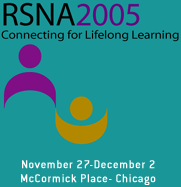
Abstract Archives of the RSNA, 2005
SSC07-08
In Vivo Magnetic Resonance Imaging of Magnetically Labelled Mesenchymal Stem Cells in Kidneys: Results in a Glomerulonephritis Model in Rats at 3T
Scientific Papers
Presented on November 28, 2005
Presented as part of SSC07: Genitourinary (Upper Tract MR Imaging)
Harald Ittrich MD, Presenter: Nothing to Disclose
Friedrich Thaiss MD, Abstract Co-Author: Nothing to Disclose
Claudia Lange, Abstract Co-Author: Nothing to Disclose
Hannes Dahnke, Abstract Co-Author: Nothing to Disclose
Gerhard Adam, Abstract Co-Author: Nothing to Disclose
Claus Nolte-Ernsting MD, Abstract Co-Author: Nothing to Disclose
To evaluate MRI for in-vivo monitoring of selectively intra-arterially injected iron oxide-labelled mesenchymal stem cells (rMSCs) in a rat model of glomerulonephritis.
10^6 bone marrow derived and magnetically labelled rMSC (Resovist (Schering, Germany), 50 µg Fe/ml incubation concentration, 24 h) were injected in the left renal artery in 6 of 12 rats (6 controls) four days after the induction of an anti-Thy1 antibody-induced glomerulonephritis. Rats of control groups received no rMSC (control group I, 3 animals) or equivalent dosages of free SPIOs (control group II, 3 animals). Viability of labelled rMSC in-vitro was checked by trypan blue exclusion and proliferation assays. In-vivo MR Imaging (T2* weighted gradient echo sequences) and MR Relaxometry measurements (2D Multi-gradient echo sequence) were performed 6 days before and at days 0, 4, 7, 11 and 22 after administration using an animal coil in a clinical whole body 3T scanner. MRI data were correlated with kidney histology (HE, Prussian blue) at days 4, 11 and 22. Statistical analyses of signal intensity (SI) changes and T2* relaxation-time were performed in both groups (student’s t-test).
Incubation with Resovist was effective for cellular labelling of rMSC. No changes in cell viability or toxic effects of SPIOs were found. Significant SI decrease (96.8-58%) and shortening of T2* (3.5–21.4ms, day 0-22) was observed in the cortex and the outer medulla of left kidneys in rMSC group up to 3 weeks after rMSC administration with glomerular predominance of labelled rMSC in histology (control group I: SI decrease 2.9±3.3%, T2* 39.4±3.1ms, p<0.05). Aberrant rMSC were detected in spleen, liver and lungs. Free SPIO injection (control group II) resulted in a significant SI and T2* decrease only in liver and spleen but not in kidneys.
Effective cell labeling of mesenchymal stem cells is possible with a clinically approved SPIO. This initial study demonstrates the potential of MRI for in-vivo cell-tracking and distribution monitoring of therapeutically administered, magnetically labelled rMSC in the kidneys after selective intra-arterial perfusion.
Ittrich, H,
Thaiss, F,
Lange, C,
Dahnke, H,
Adam, G,
Nolte-Ernsting, C,
In Vivo Magnetic Resonance Imaging of Magnetically Labelled Mesenchymal Stem Cells in Kidneys: Results in a Glomerulonephritis Model in Rats at 3T. Radiological Society of North America 2005 Scientific Assembly and Annual Meeting, November 27 - December 2, 2005 ,Chicago IL.
http://archive.rsna.org/2005/4412201.html

